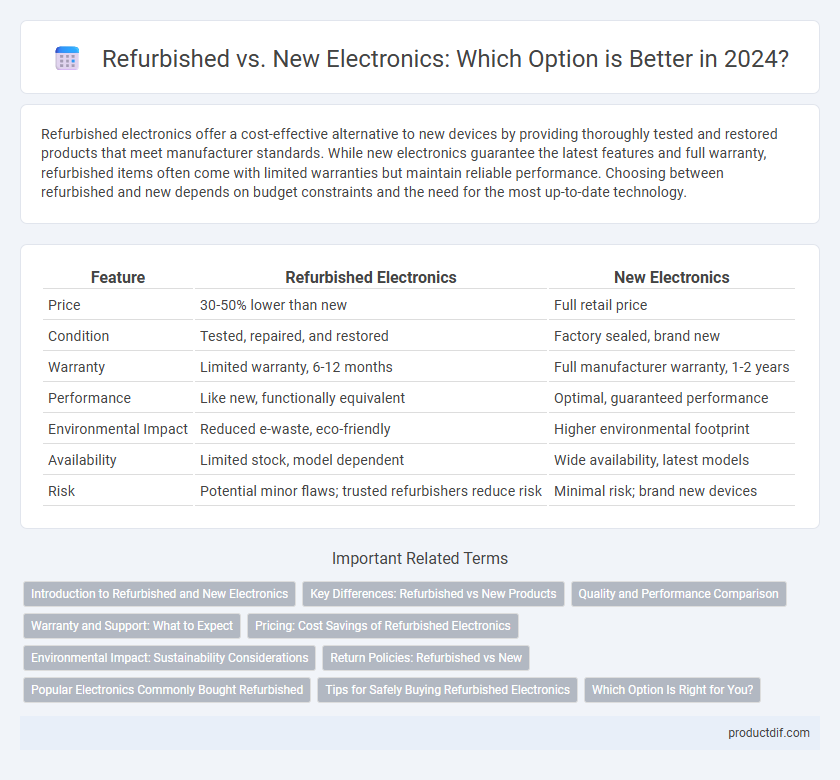Refurbished electronics offer a cost-effective alternative to new devices by providing thoroughly tested and restored products that meet manufacturer standards. While new electronics guarantee the latest features and full warranty, refurbished items often come with limited warranties but maintain reliable performance. Choosing between refurbished and new depends on budget constraints and the need for the most up-to-date technology.
Table of Comparison
| Feature | Refurbished Electronics | New Electronics |
|---|---|---|
| Price | 30-50% lower than new | Full retail price |
| Condition | Tested, repaired, and restored | Factory sealed, brand new |
| Warranty | Limited warranty, 6-12 months | Full manufacturer warranty, 1-2 years |
| Performance | Like new, functionally equivalent | Optimal, guaranteed performance |
| Environmental Impact | Reduced e-waste, eco-friendly | Higher environmental footprint |
| Availability | Limited stock, model dependent | Wide availability, latest models |
| Risk | Potential minor flaws; trusted refurbishers reduce risk | Minimal risk; brand new devices |
Introduction to Refurbished and New Electronics
Refurbished electronics undergo comprehensive testing, repairs, and quality assurance to meet manufacturer standards, offering a cost-effective alternative to new devices. New electronics provide the latest technology and full manufacturer warranties, ensuring optimal performance and reliability. Consumers choosing between refurbished and new options balance budget considerations with preferences for cutting-edge features and guaranteed freshness.
Key Differences: Refurbished vs New Products
Refurbished electronics undergo thorough testing, repairs, and quality checks to ensure functionality similar to new products, often at a lower price point. New electronics provide the latest technology with full manufacturer warranties and untouched packaging, offering maximum reliability and longevity. Key differences include warranty duration, price, cosmetic condition, and risk of defects, with refurbished items potentially showing minor wear or previous usage.
Quality and Performance Comparison
Refurbished electronics undergo thorough testing and repairs to meet manufacturer standards, often matching the quality and performance of new devices. While new electronics guarantee the latest technology and full warranty coverage, refurbished units offer significant cost savings without compromising functionality. Performance benchmarks generally show minimal differences, making refurbished options a viable choice for budget-conscious consumers seeking reliable quality.
Warranty and Support: What to Expect
Refurbished electronics typically come with a limited warranty lasting from 90 days to one year, which is shorter than the standard one to two years offered on new devices. Support for refurbished products may be more restricted, often lacking comprehensive customer service options available to new product buyers. Buyers should verify warranty terms and support accessibility when choosing between refurbished and new electronics to ensure adequate post-purchase protection.
Pricing: Cost Savings of Refurbished Electronics
Refurbished electronics typically cost 20% to 50% less than new products, offering significant savings without compromising functionality. These devices undergo rigorous testing and repairs, ensuring reliability at a fraction of the original price. Consumers benefit from lower prices while still receiving warranties and quality assurance comparable to new electronics.
Environmental Impact: Sustainability Considerations
Refurbished electronics significantly reduce e-waste by extending the lifecycle of devices and minimizing the demand for raw materials and energy-intensive manufacturing processes. New electronics contribute to higher carbon emissions and resource depletion due to mining, production, and transportation activities. Choosing refurbished products supports circular economy principles and lowers environmental footprints compared to purchasing new gadgets.
Return Policies: Refurbished vs New
Return policies for refurbished electronics often differ from those of new products, with refurbished devices typically offering shorter return windows and more limited warranties due to their pre-owned status. New electronics generally come with comprehensive return policies, including longer periods and full manufacturer warranties, ensuring greater consumer protection. Understanding these differences is crucial for buyers prioritizing risk management and post-purchase support.
Popular Electronics Commonly Bought Refurbished
Popular electronics commonly bought refurbished include smartphones, laptops, and tablets, which often show significant price reductions while maintaining reliable performance through rigorous testing and certification. Refurbished gaming consoles and smartwatches also attract consumers seeking high-quality devices at a fraction of the original cost, offering access to premium technology without the premium price tag. These refurbished products typically come with warranties, ensuring buyer confidence and protection comparable to new purchases.
Tips for Safely Buying Refurbished Electronics
Inspect the refurbished electronics for certified warranties from reputable manufacturers to ensure product reliability and return options. Verify the seller's review ratings and confirm that the device has undergone rigorous testing and quality assurance processes. Prioritize purchasing from authorized refurbishers or certified platforms to avoid counterfeit or defective units.
Which Option Is Right for You?
Choosing between refurbished and new electronics depends on budget, warranty preferences, and risk tolerance. Refurbished devices offer significant cost savings and environmental benefits but may have limited warranties and potential cosmetic wear. New electronics provide the latest technology, full manufacturer warranties, and guaranteed condition, making them ideal for users prioritizing reliability and performance.
Refurbished vs New Infographic

 productdif.com
productdif.com